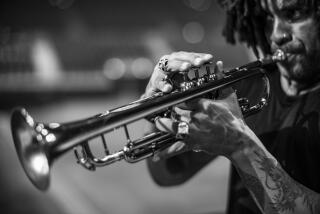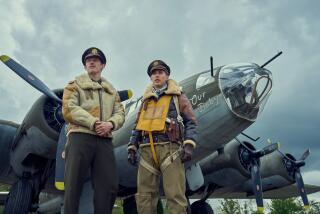Flying Ace Pappy Boyington, Who Shot Down 28 Zeros, Dies at 75
- Share via
Gregory (Pappy) Boyington, the high-flying, tough-talking retired Marine colonel who downed 28 Japanese Zeros in World War II and gave new definition to becoming a legend in one’s own time, died in his sleep Monday.
Boyington, who triumphed over alcoholism and domestic woes on the ground much as he had enemy pilots in the air, was 75 when he died of cancer at a hospice in Fresno where he had been admitted New Year’s Eve, a spokeswoman for the facility said.
“Mr. Boyington passed away at 4 a.m. in his sleep,” Nancy Hinds said. “His nurses were with him and his family had been with him most of the day Sunday.”
Boyington, whose autobiographical “Baa Baa Black Sheep” became not only a national best-seller but spawned a 1976-78 TV series, entered the hospice after a two-week stay at Fresno Community Hospital.
Early Combat
The flamboyant leader of the crack squadron, which came to be called the Black Sheep, captured the world’s attention in the unsettled days before U.S. entry into World War II.
Boyington, who fell in love with flying as a boy in Idaho when a barnstormer first took him aloft, had started a career in the Marine Corps in the late 1930s. He was flying in precision races on the East Coast but quit the service to travel to China and join Clare Chennault’s Flying Tigers in August, 1941.
Chennault had formed the maverick, volunteer group of fliers to protect the Burma Road from the Japanese prior to America’s declaration of war against Japan after Pearl Harbor Day.
With Chennault, Boyington recorded six kills beyond those he was to later claim as a “Black Sheep.”
When Boyington rejoined the Marine Corps he returned as a major and was 29, well past the age of the young fighter pilots then in the air. He also had suffered a broken leg, which further complicated his flight status.
To return to the skies he persuaded his group commander to establish a temporary squadron, putting fliers who had been rejected by other squadrons (and who were stagnating in the pilots’ pool) into the cockpits of some old Corsairs that had been set aside for training purposes.
Black Sheep Born
Thus were born the Black Sheep, a ragtag bunch of nuisances and nonconformists who operated in the Solomon Islands during 1943-44. Thus also was born the nickname “Pappy” in honor of their older leader.
With just a few weeks of training, the borrowed men and planes took to the skies and recorded 18 kills on their first mission. Five were attributed to Boyington and thus began the legend.
And the man who was billed as the oldest active Marine pilot of the war fueled it with his drinking binges, barroom brawls and penchant for disobedience.
Before he was shot down and presumed dead on Jan. 3, 1944, over New Britain Island in the Pacific, Boyington had shot 28 enemy planes from the sky.
But Boyington had parachuted safely to sea and when he returned Lazarus-like from a Japanese war camp in September, 1945, where he complained of atrocities, it was to receive a hero’s welcome and the Medal of Honor that originally had been awarded to him posthumously.
The years that followed were to be filled with notoriety of a different sort.
Instead of the glory that had accompanied his exploits during the war he went to work in department stores and refereed wrestling matches to support himself.
Conquers the Bottle
The drinking worsened and it wasn’t until the mid-1950s that he conquered it and wrote his book, which he had hoped would be made into a film. It wasn’t and Boyington made one more flight into the limelight; in 1962 as a candidate in the 30th Congressional District. He even had his name changed legally to Gregory Pappy Boyington, so it would appear on the ballot that way.
But he finished third in the June primary with Rep. Edward R. Roybal leading a five-man pack.
He returned to a disquieting obscurity shortly after and his health and family life began to fail. He had married often and had even testified against one of his two children at a custody trial involving a granddaughter.
In the early 1970s, he moved from Southern California to Fresno to undergo cancer treatment at the local Veterans Administration Hospital. He married his fourth wife, Josephine Moseman of Fresno, in 1978 and after responding to cancer therapy gradually emerged from a seclusion he had never sought.
He attended air shows, was reunited in 1977 with the man who had shot him down, retired Japanese Navy ace Masajiro Kawato, and in 1982 went to Japan at the invitation of the Zero Fighter Pilots’ Assn.
Boyington said he looked forward to meeting his old adversaries.
“Hell, I don’t think I ever looked at them as bitter enemies, just combatants on the other side,” he said. “Pilots are pilots no matter what country they fly for and they were just doing their jobs.”
Experimental Plane
He resumed flying, this time in a single-seat experimental airplane that he would take to some of the aviation shows that honored him.
And he maintained a devotion to deviltry.
In 1981 a reporter asked him about the small turquoise ribbon pinned to his lapel. It was, he replied, given to him in honor of his 30 years with the Otis Elevator company.
What it was, of course, was his Medal of Honor boutonniere.
Boyington, who is to be buried at Arlington National Cemetery, was once asked what prompted his behavior. He half-seriously explained that some of his flamboyancy may have resulted from wounds he suffered in the war.
“My skull is full of hunks of shrapnel (from being shot down by the Japanese) and every now and then one works out of the bone, so if I’m a little nutty, I’ve got a legitimate reason.”
More to Read
Sign up for Essential California
The most important California stories and recommendations in your inbox every morning.
You may occasionally receive promotional content from the Los Angeles Times.









